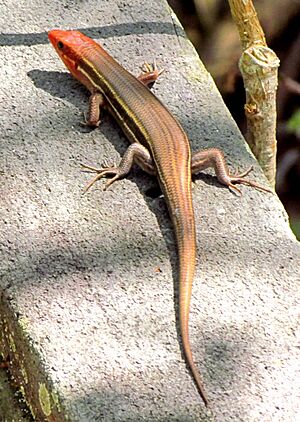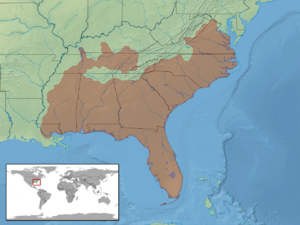Southeastern five-lined skink facts for kids
Quick facts for kids Southeastern five-lined skink |
|
|---|---|
 |
|
| Male | |
| Conservation status | |
| Scientific classification | |
| Genus: |
Plestiodon
|
| Species: |
inexpectatus
|
 |
|
| Synonyms | |
|
|
The southeastern five-lined skink (scientific name: Plestiodon inexpectatus) is a common type of skink. You can find these lizards in the southeastern United States. They are known for the five stripes on their bodies.
Contents
Why is it called "unexpected"?
The scientific name for this skink is inexpectatus. This word means "the unexpected" in Latin. Scientists think it got this name because it was discovered in 1932. This was almost 175 years after another similar skink, the American five-lined skink, was first described. It was a surprise to find a new species so much later!
What does it look like?
Southeastern five-lined skinks have five thin stripes along their bodies. These stripes become lighter as the skink gets older. The stripe in the middle is usually thinner than the others. When they are young, the areas between the stripes are black. As they grow, these dark areas turn brown.
A similar lizard is the common five-lined skink (Plestiodon fasciatus). It is a bit smaller and has wider stripes. But it can be hard to tell these two types of skinks apart just by looking at them.
Young skinks have bright tails
Young southeastern five-lined skinks have a bright blue or purplish tail. This color is brightest near the tip of the tail. Also, the stripes near their head can be a bright reddish-orange. Sometimes, this bright color stays even when the skink becomes an adult. This can make their head look orange-brown.
Where do they live?
Southeastern five-lined skinks often live in wooded areas. You can find them across the southeastern United States. They are even found on small islands off the coast. They can live there even if there isn't much fresh water or plants.
How do they behave?
These skinks are active during the day. This means they are diurnal. They spend their time on the ground.
What do they eat?
Like other skinks in their group (called Plestiodon), these lizards mostly eat insects. They prefer to hunt for larger insects, such as grasshoppers.
Reproduction and life cycle
Southeastern five-lined skinks lay eggs. This means they are oviparous. A female skink usually lays between 6 and 12 eggs at a time. The number of eggs can be fewer in colder places. The mother skink stays with her eggs. She protects them from animals that might try to eat them, including other skinks. The baby skinks hatch about one month after the eggs are laid. This usually happens around the beginning of summer.


